基于单片机自动控制窗帘设计(纯属原创)
基于单片机的智能窗帘系统设计

基于单片机的智能窗帘系统设计智能窗帘系统是一种基于单片机技术的窗帘控制系统,通过智能化的方式实现对窗帘的自动控制和远程控制。
本文将分析智能窗帘系统的设计原理及其功能,并基于单片机实现。
智能窗帘系统的设计原理:该系统主要通过感应器、单片机、驱动器和电机组成。
感应器可以感知到光线、温度、湿度等外部环境信息,单片机作为系统的控制中心,根据感应器的反馈信号,判断窗帘的状态,并做出相应的控制动作;驱动器将单片机的控制信号转换为电机控制信号,最后由电机实现窗帘的开启和关闭。
智能窗帘系统的功能设计:该系统具备以下功能:1. 自动控制:根据感应器感知到的环境信息,如光线强度超过一定阈值,则自动关闭窗帘,避免室内过度曝光;反之,当光照不足时,自动开启窗帘,增加室内光线亮度。
2. 远程控制:系统还可以通过手机App或者电脑远程控制窗帘的开关状态。
用户可以随时随地通过网络连接,实现对窗帘的遥控操作。
3. 定时控制:可以根据用户设置的定时任务,自动开启或关闭窗帘。
早上起床时自动开启窗帘,晚上睡觉时自动关闭窗帘。
4. 温度和湿度控制:系统可以通过感知器感知到室内温度和湿度,并根据设定的阈值自动控制窗帘的开合,帮助维持室内的舒适环境。
2. 软件编程:根据系统设计要求,编写单片机的控制程序。
程序需要实现感应器的数据采集、状态判断和控制信号输出。
可以使用C语言或汇编语言进行编程。
3. 测试调试:将硬件和软件进行整合,进行系统的测试和调试。
首先测试感应器的采集功能,确保能够正常感知到环境信息;然后验证单片机的控制逻辑,确保能对窗帘进行正确的开合控制;最后测试远程控制功能,确保可以通过网络连接对窗帘进行遥控操作。
4. 系统优化:根据实际使用情况,对系统进行优化和改进。
可以根据用户反馈对软件进行改进,提升系统的稳定性和用户体验。
基于单片机的智能窗帘系统可以实现自动控制、远程控制、定时控制和温湿度控制等功能。
通过硬件设计和软件编程,可以实现窗帘的智能化管理,提升室内的舒适度和使用便利性。
基于单片机控制的智能窗帘电机设计

基于单片机控制的智能窗帘电机设计第一章:引言1.1 研究背景随着智能家居的快速发展,智能窗帘作为其中的重要组成部分,逐渐受到人们的关注。
传统的手动窗帘操作不仅麻烦,而且不够智能化。
因此,基于单片机控制的智能窗帘电机的设计成为了当前研究的热点之一。
1.2 研究目的本文旨在设计一种基于单片机控制的智能窗帘电机系统,实现窗帘的自动控制,提高使用者的生活品质和舒适度。
第二章:系统设计2.1 系统架构基于单片机控制的智能窗帘电机系统主要由电机模块、单片机模块、光敏模块和通信模块组成。
其中,电机模块用于控制窗帘的开闭,单片机模块用于控制和监测窗帘的状态,光敏模块用于感知环境光强度,通信模块用于实现与其他智能设备的互联。
2.2 单片机选择在设计中,选择一款适合智能窗帘电机控制的单片机是非常重要的。
根据需求分析,我们选择了市场上常用的51系列单片机,具有较好的性能和稳定性。
2.3 电机模块设计电机模块是智能窗帘电机系统的核心部分,主要负责窗帘的开闭动作。
为了实现窗帘的平稳运行,我们选用了步进电机作为驱动电机,并设计了相应的电路,实现电机的正反转和速度控制。
2.4 光敏模块设计光敏模块用于感知环境的光强度,从而实现智能控制。
我们采用了光敏电阻作为感光元件,通过测量光敏电阻的阻值变化来获取环境光强度的信息。
2.5 通信模块设计为了实现智能窗帘电机系统与其他智能设备的互联,我们选择了无线通信模块。
通过与其他智能设备的无线连接,可以实现远程操控窗帘的功能。
第三章:系统实现3.1 硬件设计根据系统设计的要求,我们进行了硬件电路的设计和搭建。
通过连接各个模块,并按照规定的接口进行连接,实现了智能窗帘电机系统的硬件搭建。
3.2 软件设计在单片机模块中,我们设计了相应的软件程序,用于控制和监测窗帘的状态。
通过编写相应的代码,并进行调试,实现了智能窗帘电机系统的软件设计。
第四章:系统测试与分析4.1 功能测试为了验证智能窗帘电机系统的功能,我们进行了相应的测试。
基于单片机的自动窗帘控制系统设计报告

基于单片机的自动窗帘控制系统设计报告一、研究意义21世纪是信息化的时代,知识与科技成为时代的潮流,在它们的推动下,智能化也因此得到了很大的发展,其作用在社会生活中日益得到彰显。
智能控制系统主要利用计算机技术、网络通信技术、综合布线技术等现代化技术的有机结合而发挥作用。
在通信技术、计算机技术、网络技术、智能控制技术的迅猛发展潮流下,家庭生活实现了现代化与智能化,居家环境也变得更加舒适与安全。
智能化控制的工作原理自然离不开运算和控制单元,而该系统采用的主控器件正是运算与控制单元的集合体。
系统的整体主要由硬件和软件两部分组成。
硬件部分由单片机扩展的外围电路以及各种实现单片机系统控制功能的接口电路组成;软件部分主要由单片机系统实现其特定控制功能的各种程序组成。
本设计中介绍了自动窗帘控制系统的硬件构成以及软件设计过程,以尽最大可能满足不同人对窗帘开闭的不同需求。
同时,系统在针对人们一般需求的设计开发外,还提出多种解决方案,在考虑到经济性和简便性的前提下,可以供日后对控制系统的功能进行扩展。
二、设计要求该设计通过分析电动窗帘的现状和人们对自动窗帘控制系统的功能的需求,从而对自动窗帘控制器进行总体的设计。
系统的总体设计采用以步进电机作为单片机控制元件,执行窗帘开闭的主要任务;以光敏电阻作为检测元件,以提供单片机外界光照的变化;STC89C52单片机作为主控制芯片,控制着整个系统的运行,此外,辅助以键盘和显示电路,在各个电路模块的配合下最终实现了自动窗帘控制系统的智能化要求。
该系统具有一般的窗帘控制系统的最基本的功能,即通过电动按钮来开闭窗帘,在此基本功能的前提下,本设计根据需求还设计了可以根据光照强度和设定时间自动开闭窗帘的功能,在选取设计方案和采用元器件方面,该系统本着简单实用经济的思想,尽量简化电路设计,用最简单的电路布线和选用最经济实用的器件来达到设计要求。
自动窗帘控制系统具有以下几个基本功能:1)手动控制:该功能是根据用户的需求通过按键进行窗帘的开关,此功能可以使窗帘的开闭处于任何一种状态;2)光照自动控制:系统可以根据用户设定的光照强度值通过感光器采集光照自动开光窗帘;3)时间控制:此功能是根据用户设定的时间一次性开关窗帘,并显示当前温度。
基于mini stm32f407单片机的智能窗帘控制系统设计
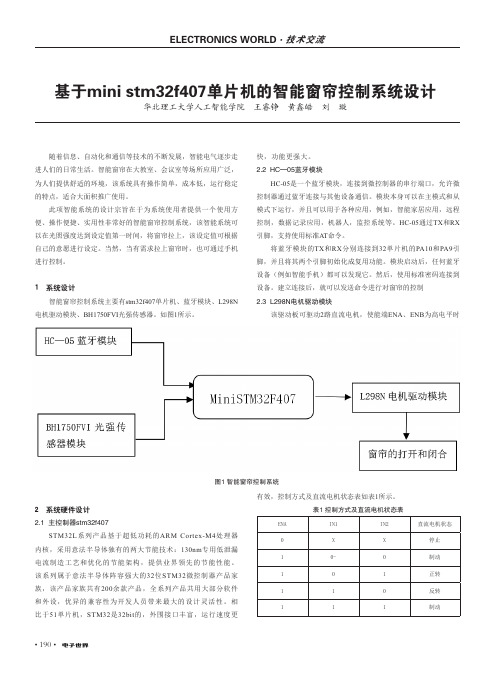
• 190•随着信息、自动化和通信等技术的不断发展,智能电气逐步走进人们的日常生活。
智能窗帘在大教室、会议室等场所应用广泛,为人们提供舒适的环境,该系统具有操作简单,成本低,运行稳定的特点,适合大面积推广使用。
此项智能系统的设计宗旨在于为系统使用者提供一个使用方便、操作便捷、实用性非常好的智能窗帘控制系统,该智能系统可以在光照强度达到设定值第一时间,将窗帘拉上,该设定值可根据自己的意愿进行设定。
当然,当有需求拉上窗帘时,也可通过手机进行控制。
1 系统设计智能窗帘控制系统主要有stm32f407单片机、蓝牙模块、L298N 电机驱动模块、BH1750FVI 光强传感器。
如图1所示。
快,功能更强大。
2.2 HC—05蓝牙模块HC-05是一个蓝牙模块,连接到微控制器的串行端口,允许微控制器通过蓝牙连接与其他设备通信。
模块本身可以在主模式和从模式下运行,并且可以用于各种应用,例如,智能家居应用,远程控制,数据记录应用,机器人,监控系统等。
HC-05通过TX 和RX 引脚,支持使用标准AT 命令。
将蓝牙模块的TX 和RX 分别连接到32单片机的PA10和PA9引脚,并且将其两个引脚初始化成复用功能。
模块启动后,任何蓝牙设备(例如智能手机)都可以发现它。
然后,使用标准密码连接到设备。
建立连接后,就可以发送命令进行对窗帘的控制2.3 L298N电机驱动模块该驱动板可驱动2路直流电机,使能端ENA 、ENB 为高电平时基于mini stm32f407单片机的智能窗帘控制系统设计华北理工大学人工智能学院 王睿铮 黄鑫皓 刘 璇图1 智能窗帘控制系统2 系统硬件设计2.1 主控制器stm32f407STM32L 系列产品基于超低功耗的ARM Cortex-M4处理器内核,采用意法半导体独有的两大节能技术:130nm 专用低泄漏电流制造工艺和优化的节能架构,提供业界领先的节能性能。
该系列属于意法半导体阵容强大的32位STM32微控制器产品家族,该产品家族共有200余款产品,全系列产品共用大部分软件和外设,优异的兼容性为开发人员带来最大的设计灵活性。
基于单片机的自动窗帘控制系统设计
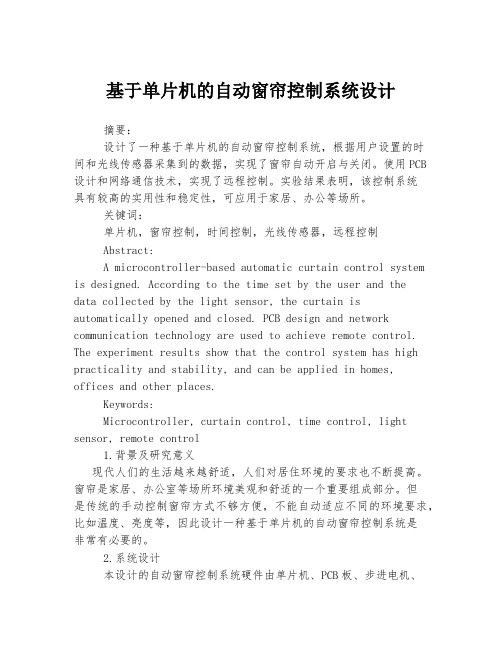
基于单片机的自动窗帘控制系统设计摘要:设计了一种基于单片机的自动窗帘控制系统,根据用户设置的时间和光线传感器采集到的数据,实现了窗帘自动开启与关闭。
使用PCB 设计和网络通信技术,实现了远程控制。
实验结果表明,该控制系统具有较高的实用性和稳定性,可应用于家居、办公等场所。
关键词:单片机,窗帘控制,时间控制,光线传感器,远程控制Abstract:A microcontroller-based automatic curtain control system is designed. According to the time set by the user and thedata collected by the light sensor, the curtain is automatically opened and closed. PCB design and network communication technology are used to achieve remote control. The experiment results show that the control system has high practicality and stability, and can be applied in homes,offices and other places.Keywords:Microcontroller, curtain control, time control, light sensor, remote control1.背景及研究意义现代人们的生活越来越舒适,人们对居住环境的要求也不断提高。
窗帘是家居、办公室等场所环境美观和舒适的一个重要组成部分。
但是传统的手动控制窗帘方式不够方便,不能自动适应不同的环境要求,比如温度、亮度等,因此设计一种基于单片机的自动窗帘控制系统是非常有必要的。
基于单片机的智能窗帘控制系统设计(自动手动光控远程温湿度)
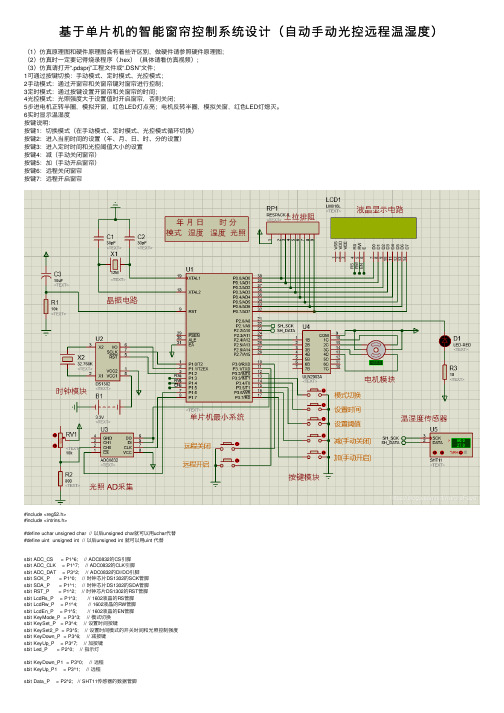
基于单⽚机的智能窗帘控制系统设计(⾃动⼿动光控远程温湿度)(1)仿真原理图和硬件原理图会有着些许区别,做硬件请参照硬件原理图;(2)仿真时⼀定要记得烧录程序(.hex)(具体请看仿真视频);(3)仿真请打开“.pdsprj”⼯程⽂件或“.DSN”⽂件;1可通过按键切换:⼿动模式、定时模式、光控模式;2⼿动模式:通过开窗帘和关窗帘键对窗帘进⾏控制;3定时模式:通过按键设置开窗帘和关窗帘的时间;4光控模式:光照强度⼤于设置值时开启窗帘,否则关闭;5步进电机正转半圈,模拟开窗,红⾊LED灯点亮;电机反转半圈,模拟关窗,红⾊LED灯熄灭。
6实时显⽰温湿度按键说明:按键1:切换模式(在⼿动模式、定时模式、光控模式循环切换)按键2:进⼊当前时间的设置(年、⽉、⽇、时、分的设置)按键3:进⼊定时时间和光控阈值⼤⼩的设置按键4:减(⼿动关闭窗帘)按键5:加(⼿动开启窗帘)按键6:远程关闭窗帘按键7:远程开启窗帘#include <reg52.h>#include <intrins.h>#define uchar unsigned char // 以后unsigned char就可以⽤uchar代替#define uint unsigned int // 以后unsigned int 就可以⽤uint 代替sbit ADC_CS = P1^6; // ADC0832的CS引脚sbit ADC_CLK = P1^7; // ADC0832的CLK引脚sbit ADC_DAT = P3^2; // ADC0832的DI/DO引脚sbit SCK_P = P1^0; // 时钟芯⽚DS1302的SCK管脚sbit SDA_P = P1^1; // 时钟芯⽚DS1302的SDA管脚sbit RST_P = P1^2; // 时钟芯⽚DS1302的RST管脚sbit LcdRs_P = P1^3; // 1602液晶的RS管脚sbit LcdRw_P = P1^4; // 1602液晶的RW管脚sbit LcdEn_P = P1^5; // 1602液晶的EN管脚sbit KeyMode_P = P3^3; // 模式切换sbit KeySet_P = P3^4; // 设置时间按键sbit KeySet2_P = P3^5; // 设置时间模式的开关时间和光照控制强度sbit KeyDown_P = P3^6; // 减按键sbit KeyUp_P = P3^7; // 加按键sbit Led_P = P2^0; // 指⽰灯sbit KeyDown_P1 = P3^0; // 远程sbit KeyUp_P1 = P3^1; // 远程sbit Data_P = P2^2; // SHT11传感器的数据管脚sbit Sck_P = P2^1; // SHT11传感器的时钟管脚。
基于32单片机的智能窗帘毕业设计
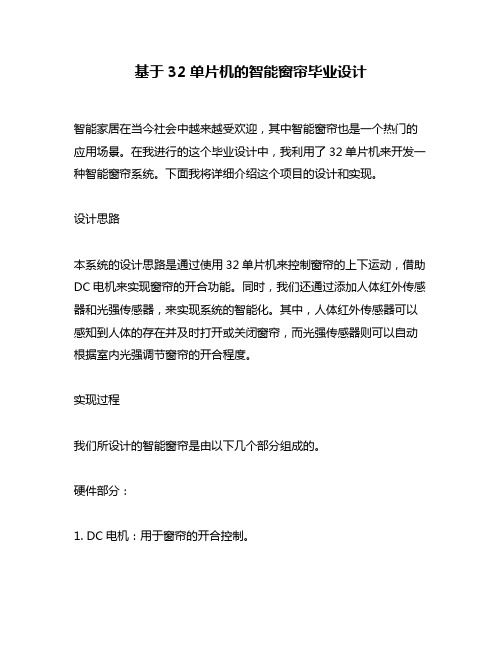
基于32单片机的智能窗帘毕业设计智能家居在当今社会中越来越受欢迎,其中智能窗帘也是一个热门的应用场景。
在我进行的这个毕业设计中,我利用了32单片机来开发一种智能窗帘系统。
下面我将详细介绍这个项目的设计和实现。
设计思路本系统的设计思路是通过使用32单片机来控制窗帘的上下运动,借助DC电机来实现窗帘的开合功能。
同时,我们还通过添加人体红外传感器和光强传感器,来实现系统的智能化。
其中,人体红外传感器可以感知到人体的存在并及时打开或关闭窗帘,而光强传感器则可以自动根据室内光强调节窗帘的开合程度。
实现过程我们所设计的智能窗帘是由以下几个部分组成的。
硬件部分:1. DC电机:用于窗帘的开合控制。
2. 32单片机:作为系统的中央控制器。
3. 人体红外传感器:用于感知人体的存在。
4. 光强传感器:用于感知室内光强。
5. 电源:用于系统供电。
软件部分:1. 窗帘控制程序:基于32单片机的C语言编写。
2. 人体红外传感器控制程序:基于32单片机的C语言编写。
3. 光强传感器控制程序:基于32单片机的C语言编写。
实现过程如下:1. 通过32单片机控制DC电机,实现窗帘的开合。
2. 利用人体红外传感器对窗帘进行自动控制,当检测到人体的存在时,窗帘自动开启。
当检测不到人体时,窗帘自动关闭。
3. 通过光强传感器实现室内光线的测量。
当室内光线过弱时,窗帘会自动开启,让阳光照射进入室内。
当光线变强时,窗帘会自动调节至适当位置。
效果展示在毕业设计的展示中,我们将智能窗帘的控制系统和电机安装在一起,通过电气连线进行控制。
在系统启动后,当有人进入房间时,窗帘会自动开启;当没有人时,窗帘会自动关闭。
此外,当室内光线间接改变时,窗帘也会相应地自动开合,完美地实现了自动调节的效果。
总结本次毕业设计中,我们成功地使用32单片机和传感器技术,开发出了一种智能化的窗帘控制系统,该系统能够自动感知人体的存在,并通过光强传感器实现自动调节。
这种智能化的窗帘控制系统不仅方便实用,同时也具有较高的安全性和舒适性,未来,智能家居将会成为家居生活的一个重要方面。
基于单片机的智能窗帘系统设计

基于单片机的智能窗帘系统设计智能家居系统已经成为现代生活中不可或缺的一部分,其带来的便利和舒适性受到了越来越多消费者的追捧。
智能窗帘系统作为智能家居的重要组成部分之一,受到了广泛的关注和应用。
本文将介绍基于单片机的智能窗帘系统设计,探讨其原理和实现方法。
一、智能窗帘系统的基本原理智能窗帘系统是通过集成了电动机和控制器的窗帘设备,利用传感器或者遥控器等方式实现对窗帘的自动控制。
基于单片机的智能窗帘系统利用单片机的高效控制能力和丰富的接口资源,实现对窗帘的智能控制和自动化管理。
二、智能窗帘系统设计的硬件部分1. 单片机:选择合适的单片机作为智能窗帘系统的控制核心,能够满足系统的实时响应和稳定性要求。
2. 电动机:选择适合的电动机作为窗帘的驱动装置,常见的有直流电动机和步进电机等,其控制方式可以通过PWM信号控制电机的转速和方向。
3. 传感器:可以选择光照传感器、温湿度传感器等作为系统的输入信号,用来感知环境的变化和调节窗帘的开合状态。
4. 无线模块:可以选择蓝牙模块、WiFi模块等实现与智能手机或者智能家居中枢的通信和控制,实现远程控制和智能化管理。
5. 电源模块:提供系统所需的稳定供电,同时考虑节能和电源管理的设计。
1. 控制算法:通过合理的控制算法实现对窗帘的精确控制,考虑到环境光照、温湿度等因素,实现窗帘的自动开合调节。
2. 用户界面:设计用户友好的界面,方便用户对窗帘系统进行手动控制和自动化设置,可以考虑通过手机App或者智能家居中枢进行集中管理。
3. 远程控制:通过无线通信模块实现与智能手机或者智能家居中枢的远程控制,便于用户在外地控制家中的窗帘设备。
4. 安全保护:考虑到窗帘系统的安全性,可以设计相应的安全保护功能,例如遇阻停止、超时自动关闭等。
四、智能窗帘系统的应用与优势智能窗帘系统可以广泛应用于家庭、办公室、酒店等场所,在提高生活品质和工作效率的还具有以下优势:1. 节能环保:智能窗帘系统可以根据环境光照和温度变化,自动调节窗帘的开合状态,达到节能减排的效果。
基于单片机的智能窗帘控制系统设计

目录摘要 (I)Abstract ................................................................................................................. I I 引言 (1)1 控制系统设计 (3)1.1 系统方案设计 (3)1.2 系统工作原理 (4)2 硬件部分设计 (6)2.1控制模块设计 (6)2.2 时钟模块 (8)2.3红外线接收模块 (9)2.4 光敏检测模块电路 (9)2.5 步进电动机控制电路 (10)2.6 液晶显示 (11)2.7电源电路 (12)3 系统原理图 (13)4 软件设计 (14)4.1系统主程序设计 (14)4.2 步进电机子程序设计 (14)4.3 按键子程序设计 (15)5焊接与调试 (17)5.1 电路焊接 (17)5.2 系统调试 (17)结论 (19)参考文献 (20)附录1 原理图 (22)附录2 源程序清单 (23)致谢 (27)摘要为了解决家居环境中手动调节窗帘调整采光避光问题,满足人们智能地调控窗帘的需求,本文设计了单片机控制的智能窗帘系统。
该系统含两种控制方式:手动和自动。
当处于手动控制状态时,人们可以自主选择打开关闭窗帘。
当系统是自动控制状态的时候,利用光照传感器与光敏电阻来进行当前环境的检测,系统控制功能则由单片机完成。
单片机将检测到的光强数据经过分析处理传递给执行模块,从而控制电动机正反转。
该窗帘系统能够根据所处环境的光照强度与时间来实现窗帘的自动打开和关闭,当光照强度比最低预设值小的时候,窗帘自动打开,相反,光照强度超出最高预设值时,窗帘自动关闭。
本次所设计智能窗帘系统不仅能够根据光照变化实现窗帘的自动打开与关闭控制,而且可以通过设定的时间进行窗帘的开关,操作简洁易懂。
这款用单片机控制的窗帘控制彻底解放人们亲自开窗帘的麻烦。
整套系统在运行中表现极好,其智能、便捷的特点也备受消费者的欢迎。
基于单片机的自动窗帘光控系统设计
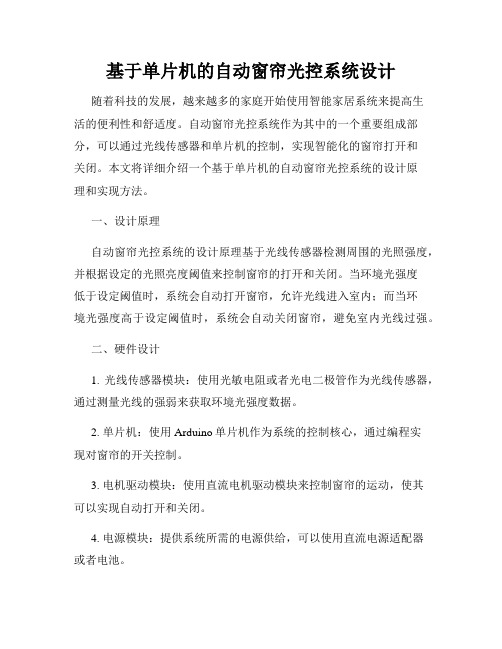
基于单片机的自动窗帘光控系统设计随着科技的发展,越来越多的家庭开始使用智能家居系统来提高生活的便利性和舒适度。
自动窗帘光控系统作为其中的一个重要组成部分,可以通过光线传感器和单片机的控制,实现智能化的窗帘打开和关闭。
本文将详细介绍一个基于单片机的自动窗帘光控系统的设计原理和实现方法。
一、设计原理自动窗帘光控系统的设计原理基于光线传感器检测周围的光照强度,并根据设定的光照亮度阈值来控制窗帘的打开和关闭。
当环境光强度低于设定阈值时,系统会自动打开窗帘,允许光线进入室内;而当环境光强度高于设定阈值时,系统会自动关闭窗帘,避免室内光线过强。
二、硬件设计1. 光线传感器模块:使用光敏电阻或者光电二极管作为光线传感器,通过测量光线的强弱来获取环境光强度数据。
2. 单片机:使用Arduino单片机作为系统的控制核心,通过编程实现对窗帘的开关控制。
3. 电机驱动模块:使用直流电机驱动模块来控制窗帘的运动,使其可以实现自动打开和关闭。
4. 电源模块:提供系统所需的电源供给,可以使用直流电源适配器或者电池。
三、软件设计1. 环境光强度检测:通过光线传感器采集到的模拟电压值,使用模拟转换器将其转换为数字信号,得到环境光强度的数据。
2. 数据处理:将环境光强度的数据与设定的光照亮度阈值进行比较,判断窗帘应该处于打开还是关闭状态。
3. 控制信号输出:根据比较结果,通过单片机的数字输出口控制电机驱动模块,输出相应的控制信号,控制窗帘的运动。
四、系统实现1. 硬件连接:将光线传感器模块、单片机、电机驱动模块和电源模块按照电路图进行正确的连接。
2. 编程实现:使用Arduino开发环境进行编程,编写代码实现光照强度数据的采集、处理和控制信号的输出。
3. 测试调试:将系统连接到窗帘上,并进行实际测试和调试,验证系统的可靠性和稳定性。
五、系统优化1. 灵敏度调节:根据实际使用情况,对光照亮度阈值进行调整,使系统更加适应不同环境光强度下的使用需求。
《单片机原理与应用》窗帘自动控制设计

2、系统硬件电路设计(给出系统的硬件电路设计,并分析其工作原理。
)
(1)自动窗帘自动控制的硬件设计
自动控制窗帘的硬件电路主要由稳压电路模块、单片机最小系统、舵机模块、光照控制模块、显示模块等组成。
(2)单片机模块和电源电路设计
单片机模块只需要复位电路和晶振电路就能满足控制要求,其中复位操作完成单片机片内电路的初始化,使单片机从一确定的状态开始运行,当单片机的复位引脚RST出现5ms以上高电平时单片机就完成了复位操作;时钟电路就是在引脚XTAL1和XTAL2外接晶体振荡器构成内部振荡方式,内部振荡方式所得的时钟信号比较稳定,实用电路中使用较多。
电源电路由L7805和电容组成,最大输入电压可达35V,最大输出电流为1.5A,输出电压为5V,这里输入用7.2V充电电池组。
由于其输出电压为5V,因此作为单片机的稳压电路芯片非常合适,而且价格便宜,其输出可直接给单片机供电。
单片机模块和电源电路如图3所示。
图3 单片机模块和电源电路
(3)舵机驱动模块
舵机有三根接线,白是数据线,黑是GND,红是VCC。
是识别高电平的时长,先将数据线置高1500微秒,然后将数据线置低20毫秒,调零电机不转动。
同样的方法,当大于1500微秒时,电
图5 GY-30光照模块以及LCD1602模块接线图
图4 读时序操作写入命令
RS=L,RW=L,D0~D7=指令码,E=高脉冲。
图5 写时序操作写入数据
RS=H,RW=L,D0~D7=数据,E=高脉冲。
图6 时序参数
3、系统软件设计(给出系统的软件设计,画出程序流程图,并给出关键。
毕业论文-基于AT89C52单片机的光感智能窗帘控制系统设计

计算机控制技术课程设计说明书基于AT89C52单片机的光感智能窗帘控制系统设计学生姓名:学号:学院:专业:电气工程及其自动化指导教师:2016年1月摘要随着生活水平的提高,智能家居越来越被人们关注。
智能窗帘也随着科技发展悄然兴起,它不但具备窗帘优雅美观的特点,而且还能提供智能化的服务,使家居生活更加舒适、温馨与贴心。
本文设计的是基于单片机控制系统的智能窗帘。
它具备光感、红外遥控、温度显示、定时等功能。
该窗帘可以根据外界的光亮程度来控制窗帘开启,从而达到调节室内光线,同时还提供按键来控制窗帘的关合。
为了方便用户使用,增设定时模块,用户可根据自身的需要对某段时间,设置窗帘的开启程度。
当定时结束,窗帘自动切换到光感模式实现对室内光线的控制。
同时,还增设温度显示,使用户可以了解温度状况。
关键词:智能窗帘:红外遥控;光感控制;单片机目录第1章绪论 (1)1.1 设计的背景和意义 (1)1.2 本设计的内容 (1)1.3 存在的主要问题 (2)1.3.1 光感功能的实现 (2)1.3.2 遥控功能的实现 (2)第2章总体方案设计 (4)2.1 主控制系统CPU (4)2.2 窗帘结构安装及电机选择 (6)2.2.1 窗帘结构安装 (6)2.2.2 步进电机选择 (6)2.3 硬件总体方案 (7)2.3.1方案设计说明 (8)2.3.2方案选择说明 (8)3.1 光电传感器信号采集模块设计 (10)3.3 执行单元模块设计 (16)第4章系统软件设计 (21)4.1 程序流程 (21)4.2 程序设计 (22)5课程设计体会 (24)参考文献 (25)附录硬件电路图 (26)第1章绪论1.1 设计的背景和意义21世纪是信息化的世纪,各种电信和互联网新技术推动了人类文明的巨大进步。
利用先进的计算机技术、网络通讯技术、综合布线技术、将与家居生活有关的各种子系统,有机地结合在一起,通过统筹管理,让家居生活更加舒适、安全、有效。
基于单片机的智能窗帘系统设计

基于单片机的智能窗帘系统设计1. 引言1.1 研究背景随着科技的不断发展,智能家居系统已经成为了人们生活中的一部分。
智能窗帘系统作为智能家居系统中的一种重要组成部分,具有自动开关、遥控操作等功能,极大地方便了人们的生活。
传统的窗帘控制方式通常需要人工操作,不仅费时费力,而且不够智能化。
基于单片机的智能窗帘系统的设计与研究具有非常重要的意义。
通过引入单片机技术,智能窗帘系统可以实现更加智能化的控制方式,比如可以根据时间、光线、温度等参数自动调节窗帘的开合程度,实现智能化的控制。
基于单片机的智能窗帘系统还可以通过手机App等远程控制方式,实现更加方便的操作体验。
本文旨在设计并实现一种基于单片机的智能窗帘系统,探讨其系统架构设计、硬件设计、软件设计、通信协议设计等关键技术,并对实验结果进行分析,最终总结设计的优缺点,展望未来的研究方向,为智能家居系统的发展贡献一份力量。
1.2 研究意义智能窗帘系统的设计与研究在当今智能家居领域具有重要的意义。
智能窗帘系统的推出能够提高家居生活的便利性和舒适性,用户可以通过智能手机或语音控制设备来轻松操作窗帘开合,避免了传统手动操作带来的不便和繁琐。
智能窗帘系统可以有效节约能源,通过预设定的时间或光线感应等功能,可以根据用户需求自动开合窗帘,有效利用自然光线,降低能耗,提高能源利用效率。
智能窗帘系统还可以与其他智能家居设备联动,实现更智能化、自动化的家居生活体验,如与智能灯具、空调等设备配合,共同构建智能家居生态系统。
研究智能窗帘系统具有明显的社会和经济意义,有利于推动智能家居技术的发展和普及,提高生活质量,推动节能减排,促进智能家居产业的发展。
1.3 研究目的研究目的:本文旨在设计基于单片机的智能窗帘系统,通过结合单片机的控制能力和传感器技术,实现对窗帘的自动控制和智能化管理。
具体目的包括:提高窗帘的开启和关闭效率,使其能够根据用户需求和环境变化自动调整;增强窗帘的安全性,减少因操作不当而导致的意外事故发生;提升窗帘的舒适性和便利性,让用户能够通过智能手机或语音控制实现远程操作;探索窗帘系统的智能化发展方向,为未来智能家居技术的应用提供参考。
基于单片机的智能窗帘系统设计

基于单片机的智能窗帘系统设计智能家居系统在近年来的发展中越来越受到人们的关注和青睐,其中智能窗帘系统作为智能家居系统的重要组成部分,能够为用户提供便捷、舒适的居家体验。
利用单片机技术制作智能窗帘系统已经成为目前的趋势,本文将介绍基于单片机的智能窗帘系统的设计原理和实现过程。
一、系统设计原理1. 系统功能智能窗帘系统是一种智能化家居系统,主要功能是实现窗帘的自动开合、遥控操作以及与其他家居设备的联动控制。
通过传感器检测环境信息,经过处理后控制窗帘的开合,使得窗帘能够根据环境光照和用户需求进行自动调节。
2. 系统组成基于单片机的智能窗帘系统主要由单片机、光敏电阻传感器、继电器、直流电机、无线模块等部分组成。
单片机是系统的核心控制器,负责接收传感器信号并进行控制决策,同时完成与用户的交互操作和与其他设备的通信。
3. 系统工作原理智能窗帘系统的工作原理是通过光敏电阻传感器检测环境光照强度,并将信号传输给单片机进行处理,单片机根据预设的阈值进行判断,控制继电器实现窗帘的开合。
在系统设计中,还可以通过添加无线模块实现远程遥控和与其他智能设备的联动控制,提升系统的智能化水平。
1. 控制部分设计在基于单片机的智能窗帘系统中,控制部分由单片机和继电器构成。
单片机作为系统的核心控制器,既能够接收传感器的信号,又能够控制继电器实现窗帘的开合。
继电器作为电能的控制器,负责控制窗帘的上下运动,通过控制继电器的通断来实现窗帘的开合操作。
传感部分由光敏电阻传感器构成,用于检测环境光照强度。
光敏电阻传感器将检测到的光照信号转换成电信号,然后传输给单片机进行处理。
通过光敏电阻传感器的信号,单片机可以判断当前的光照强度,从而决定窗帘的开合状态。
通信部分是智能窗帘系统的一个重要组成部分,通过无线模块实现与用户的远程遥控和与其他智能设备的联动控制。
用户可以通过手机APP或者遥控器发送控制指令,单片机接收到指令后实现相应的动作。
通过与其他智能设备的联动控制,可以实现更加智能化的家居体验。
基于单片机控制的智能窗帘系统设计

基于单片机控制的智能窗帘系统设计This article introduces the basic knowledge and n prospects of smart homes。
and emphasizes the importance of developing an infrared remote control automatic curtain system as an important part of smart homes。
The article focuses on the hardware structure principle of the integrated chips STC89C52.DS1302 chip。
infrared transmitter and receiver used in the development of the MCU-controlled infrared remote control curtain system。
The hardware circuit design of the entire system is analyzed in a block-by-block pattern。
including the system overall diagram。
power supply circuit。
DS1302 clock circuit。
buzzer circuit。
infrared receiver circuit。
motor control circuit。
and display circuit。
The corresponding circuit design is also explained。
The are writing ideas are then discussed in a block-by-block pattern。
基于单片机的智能窗帘系统设计
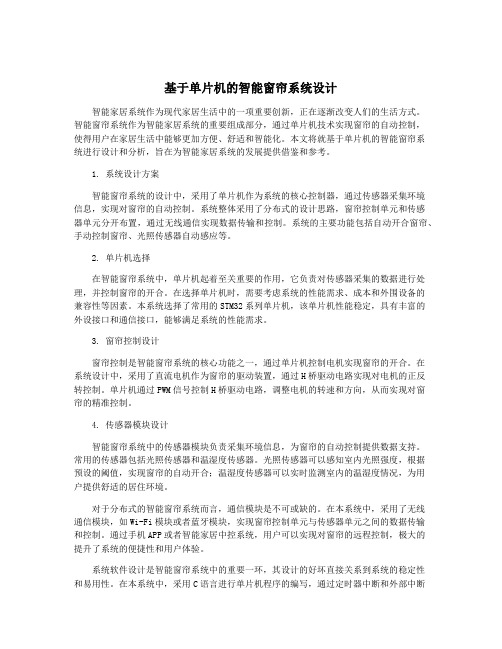
基于单片机的智能窗帘系统设计智能家居系统作为现代家居生活中的一项重要创新,正在逐渐改变人们的生活方式。
智能窗帘系统作为智能家居系统的重要组成部分,通过单片机技术实现窗帘的自动控制,使得用户在家居生活中能够更加方便、舒适和智能化。
本文将就基于单片机的智能窗帘系统进行设计和分析,旨在为智能家居系统的发展提供借鉴和参考。
1. 系统设计方案智能窗帘系统的设计中,采用了单片机作为系统的核心控制器,通过传感器采集环境信息,实现对窗帘的自动控制。
系统整体采用了分布式的设计思路,窗帘控制单元和传感器单元分开布置,通过无线通信实现数据传输和控制。
系统的主要功能包括自动开合窗帘、手动控制窗帘、光照传感器自动感应等。
2. 单片机选择在智能窗帘系统中,单片机起着至关重要的作用,它负责对传感器采集的数据进行处理,并控制窗帘的开合。
在选择单片机时,需要考虑系统的性能需求、成本和外围设备的兼容性等因素。
本系统选择了常用的STM32系列单片机,该单片机性能稳定,具有丰富的外设接口和通信接口,能够满足系统的性能需求。
3. 窗帘控制设计窗帘控制是智能窗帘系统的核心功能之一,通过单片机控制电机实现窗帘的开合。
在系统设计中,采用了直流电机作为窗帘的驱动装置,通过H桥驱动电路实现对电机的正反转控制。
单片机通过PWM信号控制H桥驱动电路,调整电机的转速和方向,从而实现对窗帘的精准控制。
4. 传感器模块设计智能窗帘系统中的传感器模块负责采集环境信息,为窗帘的自动控制提供数据支持。
常用的传感器包括光照传感器和温湿度传感器。
光照传感器可以感知室内光照强度,根据预设的阈值,实现窗帘的自动开合;温湿度传感器可以实时监测室内的温湿度情况,为用户提供舒适的居住环境。
对于分布式的智能窗帘系统而言,通信模块是不可或缺的。
在本系统中,采用了无线通信模块,如Wi-Fi模块或者蓝牙模块,实现窗帘控制单元与传感器单元之间的数据传输和控制。
通过手机APP或者智能家居中控系统,用户可以实现对窗帘的远程控制,极大的提升了系统的便捷性和用户体验。
基于单片机的智能窗帘系统设计
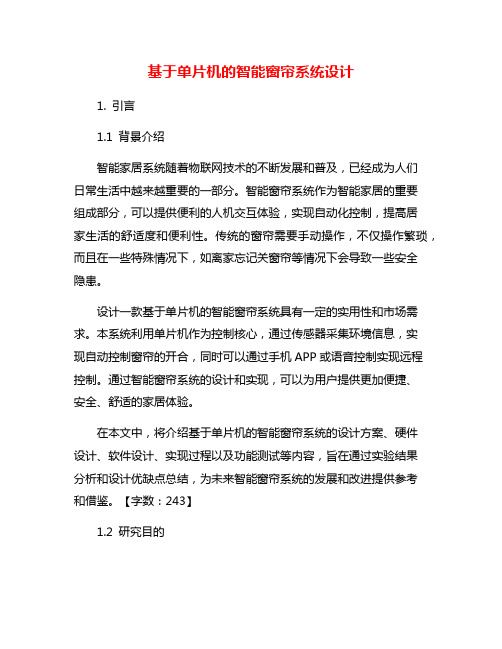
基于单片机的智能窗帘系统设计1. 引言1.1 背景介绍智能家居系统随着物联网技术的不断发展和普及,已经成为人们日常生活中越来越重要的一部分。
智能窗帘系统作为智能家居的重要组成部分,可以提供便利的人机交互体验,实现自动化控制,提高居家生活的舒适度和便利性。
传统的窗帘需要手动操作,不仅操作繁琐,而且在一些特殊情况下,如离家忘记关窗帘等情况下会导致一些安全隐患。
设计一款基于单片机的智能窗帘系统具有一定的实用性和市场需求。
本系统利用单片机作为控制核心,通过传感器采集环境信息,实现自动控制窗帘的开合,同时可以通过手机APP或语音控制实现远程控制。
通过智能窗帘系统的设计和实现,可以为用户提供更加便捷、安全、舒适的家居体验。
在本文中,将介绍基于单片机的智能窗帘系统的设计方案、硬件设计、软件设计、实现过程以及功能测试等内容,旨在通过实验结果分析和设计优缺点总结,为未来智能窗帘系统的发展和改进提供参考和借鉴。
【字数:243】1.2 研究目的研究目的是为了探讨基于单片机的智能窗帘系统在家居生活中的应用,通过设计和实现一个智能窗帘系统,实现窗帘的自动控制和智能化管理。
我们的研究目的是为了让用户能够方便地通过手机或者语音控制窗帘开合,实现智能化的家居环境,提升生活品质和便利性。
我们还希望通过对智能窗帘系统的研究,探讨如何利用单片机等硬件设备来实现家居设备的智能化控制,进一步推动智能家居技术的发展和应用。
通过本研究,我们希望能够为智能家居领域的发展和创新提供一定的参考和借鉴,为消费者带来更加智能化和便捷的生活体验。
1.3 研究意义智能窗帘系统作为智能家居的一部分,可以为人们提供更加便捷、舒适的生活体验。
通过对智能窗帘系统的研究与设计,可以在实践中验证单片机在智能家居领域的应用价值。
智能窗帘系统还可以有效地提高生活的便利性和舒适度,满足人们对智能化生活的需求。
智能窗帘系统的研究也有助于推动智能家居技术的发展,促进智能家居产品的商业化应用。
基于51单片机的智能窗帘控制系统设计

基于51单片机的智能窗帘控制系统设计智能家居技术的快速发展使得我们的家居生活更加智能化和便利化。
其中,智能窗帘控制系统作为其中一个重要组成部分,带来了更加舒适和人性化的体验。
本文将介绍一种基于51单片机的智能窗帘控制系统设计。
一、系统设计概述智能窗帘控制系统设计旨在通过使用51单片机作为核心控制器,实现对窗帘的自动控制。
系统能够根据光线传感器的数据,自动调节窗帘的开闭程度,同时也支持用户手动控制。
二、硬件设计1. 51单片机51单片机是一种常见的嵌入式控制芯片,具有良好的稳定性和灵活性。
该单片机能够通过编程控制各种外设,如光线传感器、电机驱动模块等。
2. 光线传感器光线传感器用于感知环境的光线强度。
基于这个数据,系统能够判断当前是否需要调节窗帘的开闭程度。
3. 电机驱动模块电机驱动模块负责控制窗帘的开闭。
通过控制不同的电机转速和方向,实现窗帘的自动开关。
4. 人机交互模块人机交互模块包括按键、液晶屏等设备,用于用户手动控制窗帘的开闭,同时也显示系统的运行状态和参数。
三、软件设计1. 硬件初始化在系统启动时,需要对各个硬件设备进行初始化,并进行必要的设置,如引脚配置、中断配置等。
2. 光线传感器数据采集系统通过光线传感器实时采集光线强度数据,并通过模数转换将其转化为可用的数字信号。
3. 窗帘控制算法基于光线传感器数据,系统根据预设的算法判断窗帘的开闭程度。
当光线强度较弱时,窗帘自动关闭;当光线强度较强时,窗帘自动打开。
算法还可以考虑其他因素,如时间、季节等。
4. 手动控制模式系统支持用户手动控制窗帘的开闭。
用户可以通过按键或其他人机交互设备来实现手动操作。
5. 显示与反馈系统通过液晶屏等设备将系统的运行状态和参数显示给用户,同时也可以通过提示音或其他方式进行反馈,以增强用户的交互体验。
四、系统实现与测试在完成系统设计后,需要进行系统的实现和测试。
首先,按照硬件设计部分的要求进行电路的搭建和元件的连接。
- 1、下载文档前请自行甄别文档内容的完整性,平台不提供额外的编辑、内容补充、找答案等附加服务。
- 2、"仅部分预览"的文档,不可在线预览部分如存在完整性等问题,可反馈申请退款(可完整预览的文档不适用该条件!)。
- 3、如文档侵犯您的权益,请联系客服反馈,我们会尽快为您处理(人工客服工作时间:9:00-18:30)。
专科生毕业论文题目:基于单片机自动控制窗帘设计学生姓名:学号:院系:机械与控制工程学院专业年级:指导教师:2015年 6 月15 日摘要目前,家庭居住环境的采光及避光问题主要采用的是手动开闭窗帘,手动开闭不仅费力而且很多方面不够人性化,会对用户造成一定的困扰。
本文设计的自动窗帘控制系统可这些问题。
本文主要阐述了自动窗帘控制的设计过程。
以AT89C51单片机为控制核心,以光敏电阻和雨滴传感器为传感器件,以步进电机为执行器件。
在设计的同时对单片的理论基础和外围扩展知识进行了比较全面准备。
硬件采用分块的模式,对整个系统的电路设计进行分析,分别给出了系统的整体框图,显示电路,检测电路,系统总控制模板等相关电路,随后说明系统软件的编写过程,同样采用的是分块的模式,且每一个模块都给出了相应的流程图。
本设计利用单片机实现了半自动控制、自动控制、定时控制的相互转换,智能的控制窗帘的动作。
通过调试,时钟控制、手动开关窗帘、自动开关窗帘等控制方面的设计基本达到了预期效果。
具有较强的实用价值。
关键词:单片机,自动窗帘,步进电机,自动控制。
AbstractNow,according to the requirements of living environments. This paper describes the process of intelligent curtain controller. This design uses AT89C51 microcontroller as the control,introduce microcontroller-based optical curtain curtain system,the main structural principle of the hardware and software programming to explain.In the design for monolithic integrated circuits,and peripheral to expand the basic the theories of knowledge was fairly comprehensive preparation. Block the model of hardware used,the circuit design of the entire system to analyze the overall block diagram of the system are given,display circuit,photoelectric switch circuit,system control module,power conversion circuits,protection circuits and other related circuit;then describes the software the preparation process,but also by the sub-block pattern,with each module to draw a corresponding flow chart.In this paper,use the AT89C51 microcontroller,according to their different modes,to achieve semi-automatic control,automatic control,timing control of the conversion and intelligent motion control curtains. Debugging by simulation,clock control,manual switch curtains,the curtains automatically switch the basic design of such control to achieve the desired effect,with a strong practical value.Key words:SCM 、intelligent curtain、stepping motor、automatic control.目录摘要 (I)Abstract (III)第1章绪论...............................................................1.1 研究目的和意义.................................................... - 1 –1.2 国内外发展状况.................................................... - 2 - 1.3 课题的目的任务和要求.............................................. - 2 - 第2章系统方案论证....................................................... - 5 –2.1 方案选取.......................................................... - 5 -2.2 总体设计方案...................................................... - 8 -2.2.1 系统基本功能................................................. - 8 -2.2.2 系统总体结构设计............................................. - 9 -第3章系统硬件分析设计.................................................. - 11 - 3.1 系统硬件总设计................................................... - 11 -3.2 各单元电路设计................................................... - 12 -3.2.1 控制电路设计................................................ - 12 -3.2.2 检测电路设计................................................ - 16 -3.2.3 执行电路设计................................................ - 18 –3.2.4 键盘显示接口电路...........................................- 21 -第4章系统软件设计...................................................... - 27 - 4.1 系统软件总设计................................................... - 27 -4.2 系统软件子程序设计............................................... - 28 - 4.2.1 步进电机程序设计............................................ - 28 -4.2.2 键盘程序设计................................................ - 29 -4.2.3 定时程序设计................................................ - 31 -第5章测试和调试........................................................ - 33 - 5.1 硬件调试......................................................... - 33 -5.1.1 28BYJ-48步进电机:......................................... - 33 - 5.1.2 DS1302时钟芯片 (36)5.1.3 LM双电压比较器集成电路 (37)5.2 软件调试 (38)5.3 系统联调 (38)总结 (43)参考文献致谢附录第1章绪论1.1研究目的和意义21世纪是科技飞速发展的时代,单片机的应用也随之越来越广泛。
在这样高速发展的环境下,各种新型产品犹如雨后春笋,单片机的作用也越发重要单片机是一种集成电路芯片,是采用超大规模集成电路技术把具有数据处理能力的中央处理器CPU随机存储器RAM、只读存储器ROM、多种I/O口和中断系统、定时器/计时器等功能集成到一块硅片上构成的一个小而完善的微型计算机系统,在工业控制领域的广泛应用。
从上世纪80年代,由当时的4位、8位单片机,发展到现在的32位300M的高速单片机。
单片机具有高集成度、高可靠性,控制功能强,低电压、低功耗,优异的性价比。
由于这些优良的特性,单片机广泛的应用到工业控制,智能家电,汽车电子,楼宇自动化,医疗器械。
日常生活中,验钞机、门禁系统、电子监控、变频空调等也使用到了单片机。
在材料科学、工业技术、计算机技术的发展与进步的带动下,电路系统向着高度集成的方向发展。
CPU的生产制造技术,也朝着综合性、技术性、实用性发展。
其告诉的发展可以用日新月异来形容。
其中单片机的重要性越来越越突出,在控制系统中的应用越来越普遍。
要进行单片机系统的设计首先,要有一定的基础知识;第二,需要具有一定的软件设计能力,能够根据设计的要求,写出所需程序;第三,要灵活的把知识综合运用。
另外,单片机也经常应用到一些小系统的设计。
本系统就是依靠AT89C51单片机的优点顺利设计出来的。
随着科技的发展,人们生活水平不断提高,使得人们于居住的空间的环境有了更高的要求,人们希望居住空间更加的舒适、便捷。
这是人类发展的必然规律。
科技把人们的生活变的更加智能化,使人们生活的更加舒适、便捷。
人们的生活离不开窗帘,它保护了人们的隐私。
对于现代的建筑,对于窗帘的要求也越来越高,既能解决每天手动开关的麻烦,又能显示出生活的档次,所以窗帘自动系统会越来越普及。
